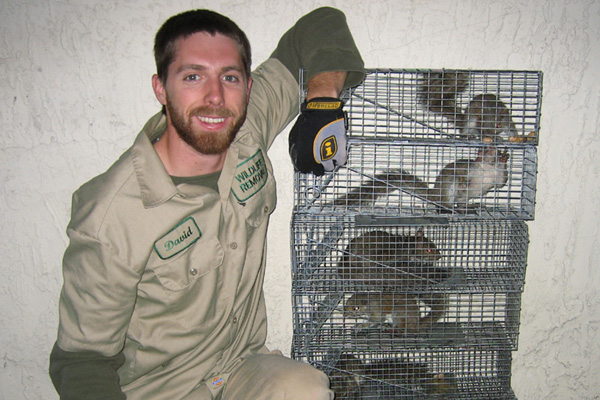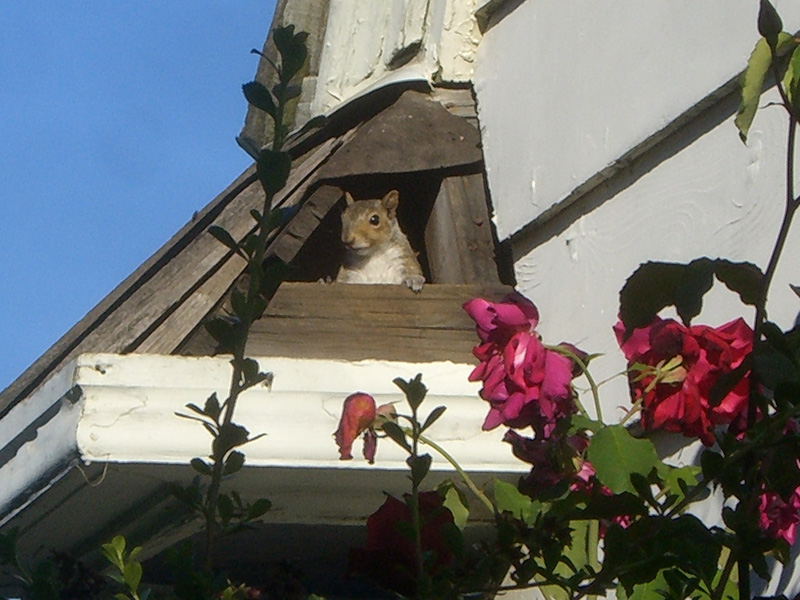- USA Wildlife Removal Education Guide and Resources
How to Get Rid of Squirrels
If you have unwanted squirrels inside or outside the home, in some cases, the only way to get rid of them is to trap and remove them. In other cases, they can possibly simply be excluded from a house using one-way exit doors. Trapping is an art, as is exclusion and most amateur attempts go awry for a variety of reasons. An intimate knowledge of squirrel behavior, and of various squirrel exclusion devices and trap types is necessary to ensure success.
- STEP 1: Determine if trapping is necessary, or if there is a preventative alternative.
- STEP 2: Select the right trap for the situation, of at least a dozen types of squirrel traps.
- STEP 3: Set the traps in the correct areas, in shade, camouflaged, mounted in trees, etc.
- STEP 4: Use correct bait, but to be honest, trap setup & location are more important.
- STEP 5: Monitor the trap daily, remove trapped squirrels and transport them.
- STEP 6: If the squirrels were inside a house, do the same as above, but consider a one-way exclusion door, mounted on the squirrel holes. Once all the squirrels are out, seal the entry hole shut with steel repairs.
Squirrels are a destructive bunch, and like most other rodents, their destructive nature goes hand-in-hand with their need to chew. If you are having an issue with squirrels in your house, most likely the attic, chances are you’ve been sitting in your living room, wondering what is making that annoying noise over your head. It’s louder than a mouse, and every once in a while it sounds like there is a small herd of somethings running around your attic. Depending on the type of squirrel living upstairs, you can have anywhere from one to twelve squirrels sharing your home. These animals are most effectively removed by live trapping with one-way exclusion doors, repeater traps, or cage traps. Live trapping is most effective because you can deal with a large number of squirrels all at once. No matter how you go about trapping the squirrels, it is very important that you determine if any babies have been left behind in the attic. Hidden babies will often die and create a foul odor that will waft through the premises. After all the squirrels are gone, clean up the space and immediately seal off any entry points. If you do not do a thorough sealing job, more squirrels will move in and create trouble.


Squirrels like chimneys because they are warm, and in the off-season, chimneys provide reliable shelter and easy access to the outside. Squirrels don’t always live inside of chimneys; they often live in the spaces next to them within the roof or attic. The best method of control for squirrels inclined to live in this part of a home is to trap them during warm weather using a one-way door. Once the squirrels are out of the chimney, a chimney cap can be secured to the top to prevent any new rodents from moving in. For those squirrels living next to the chimney, live traps can be effective if placed in strategic areas of the attic or crawl space. Live trapping is the most efficient route of capture for problematic squirrels, allowing you to eliminate multiple animals with one trap. Once your squirrels have been safely relocated, sealing up the spaces around your chimney is a must. Squirrels can squeeze through tiny openings, and they are not afraid to rip open those spaces that are too small initially. Proper sealing and patching is vital to squirrel control. If once spot is missed, more squirrels will arrive to replace the ones removed.
GET HELP: Do you need professional help with a squirrel problem? We have wildlife experts servicing almost every area of the USA! HIRE US IN YOUR TOWN
COSTS: You may want to read more about squirrels or the prices we charge for our services: READ ABOUT OUR SQUIRREL PRICES
How to Get Rid Of Squirrels in the Wall
It’s bad enough if you’ve got squirrels in your attic, but once they decide they want to invade your walls as well, you know you’re really in trouble. Squirrels chew, and that chewing is why it is very concerning to have these small creatures wandering in the support structure of your home. Wires, cable and duct work are all fair game when it comes to squirrel destruction. Not only can this damage be expensive and difficult to repair, it can be a potential hazard within your walls. Getting rid of a squirrel in the wall means finding where the squirrel is entering the home. It’s not practical to open your wall up and somehow slide a trap between the drywall. By finding the openings in your house, you can install one-way, live traps, cage traps that allow the squirrel to exit but not return. Once the animal has been captured and relocated, you can seal up the entry point and repair the damage in your home. Squirrels in the walls present the additional complication of giving birth in any number of unreachable places inside the home. If you suspect you have had a squirrel in your wall for an extended period of time, consider the help of a professional to determine if any infant squirrels may be left behind.
How to Get Rid of Squirrels in the Yard
Squirrels in the yard are an annoyance, especially for those homeowners who enjoy watching the song birds alight on the birdfeeders in the morning. Squirrels will often harass birds in order to steal the bird seed, and some larger squirrels will do irreparable damage to feeders trying to get at food. The best way to get rid of squirrels in your yard is to make their lives as difficult as you can. If you live in a rural setting, be realistic—you will probably never be squirrel-free. By using some tricky exclusion methods, however, you can keep the squirrels at a manageable level. Some tricks to try include placing firm tubing over your clotheslines or cable wires to prevent squirrels from running along them, installing metal plates at the base of your birdfeeder pole to prevent climbing up to the seed, and installing bird feeders on poles instead of in trees. If the squirrel is unable to get a secure grip, it will be unable to climb up to the seed. Animals are a temporary fix. Some dogs and cats will chase squirrels, but most house pets do not do their fair share in rodent control.
How to Get Rid of Squirrels in the Ceiling
Squirrels in the ceiling are not necessarily squirrels in an attic, though most of the time those two issues are one and the same. Some homes do not have traditional attics, but most have some form of buffer zone between the finished interior and the shingles on the roof. Homes with a squirrel issue in the ceiling can be one of the most tricky to deal with. Often homes without attics are tall, cathedral-like homes with steep roofs and unreachable peaks. If a squirrel has managed to penetrate the area between the roof and the interior, the only way to eliminate the problem is to find where the squirrels are entering and exiting. Once this location has been discovered, a live trap with a one-way door can be installed, confining the squirrels as they leave the home. Once all the squirrels are gathered, the holes can be patched. High ceilings can mean big problems if baby squirrels are not accounted for. You may have managed to place your traps in the most unreasonable of locations, but how will you go about finding and removing baby squirrels if any are present? In this situation, consider enlisting the aid of a professional.
Go back to the main Squirrel Removal page for more information about how to get rid of squirrel.


